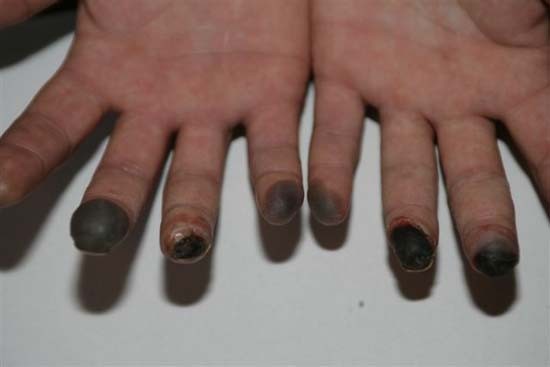Spot the Safety Hazard: How Would You Treat Worker with Frostbit Hands?
Would you know what to do if your co-worker had hands like these’

Step 1: Diagnose: Frozen, stiff and blackened fingers like these are a sure sign of frostbite.
Step 2: Treat: The best way to treat frostbite is to get the victim to a warm room and loosely cover the affected area until it warms up. Do NOT warm the affected area by rubbing it or directly exposing it to fire, a heat lamp or other heat source.
The Moral: There are different forms of cold stress and you need to be able to recognize the signs and symptoms of each one so you know how to properly treat it.
WHAT’S AT STAKE: COLD STRESS CAN KILL
Being cold isn’t just uncomfortable; it can cause serious injury and, in extreme cases, even kill you. In the U.S., approximately 700 people die of cold-related injuries each year—that’s higher than the number of fatalities caused by floods and tornadoes. These cold-related injuries, which are known as “cold stress” can happen at work.
WHO’S AT RISK
You’re at risk of cold stress if you work outdoors, in/near/above water or inside freezers or refrigerated facilities, including:
- Construction;
- Utilities;
- Mining;
- Oil and gas extraction;
- Transportation and truck driving;
- Agriculture;
- Lumber;
- Fishing;
- Mortuaries; and
- Food production and warehousing.
HOW COLD STRESS HAPPENS
Normal body temperature is 36°C (98.6°F). Minor and short-term decreases in body temperature are uncomfortable but generally not dangerous; but when core body temperature drops below 35°C (95°F), the body has trouble circulating blood. Result: The body becomes susceptible to cold stress. The longer the exposure to sub-35°C (95°F) temperatures, the greater the danger.
HOW TO RECOGNIZE & TREAT COLD STRESS
If you work in cold conditions, you and your co-workers may be at risk of 4 kinds of cold stress. Make sure you know the signs and symptoms of each one so you can recognize and properly treat the condition:
1. Frostbite
Freezing of the extremities (fingers, toes, nose, earlobes, etc.) caused by loss of blood flow, which can cause tissue damage and amputation.
Frostbite Signs & Symptoms
- Bluish or pale, waxy skin
- Blackened skin (extreme cases)
- Blistering
- Numbness, tingling, stinging sensation
Frostbite First Aid Treatment
- Get into warm room ASAP
- Loosely cover affect area
- Give victim warm, sweetened (nonalcoholic) drinks
- Allow victim and affected area to warm up
- DO NOT rub affected area
- DO NOT directly expose the affected area to fire, heat lamp or other heat source that can cause burns
- DO NOT break blisters
2. Trench Foot (aka Immersion Foot)
Injury to the feet caused by prolonged exposure to cold and/or wet conditions which causes blood flow to the feet to shut down, potentially resulting in tissue damage and amputation
Trench Foot Signs & Symptoms
- Reddening
- Foot turns dark purple, blue or gray (extreme cases)
- Swelling
- Blistering
- Bleeding under the skin
- Numbness
- Tingling pain
- Leg cramps
Trench Foot First Aid Treatment
- Remove wet shoes, boots and socks
- Dry the feet
- DO NOT let the victim walk because it can cause tissue damage to the feet
3. Chilblains
Tissue damage, typically to the feet or hands that occurs when exposure to cold damages beds of capillary or small blood vessels in the skin
Chilblains Signs & Symptoms
- Reddening
- Inflammation
- Blistering
- Ulceration, i.e., formation of open sores (extreme cases)
- Itchiness
Chilblains First Aid Treatment
- Slowly warm skin
- Keep blisters/ulcers clean and covered
- Treat with corticosteroid creams
- DO NOT scratch the itch
- DO NOT break blisters
4. Hypothermia
The most dangerous form of cold stress that occurs when body temperature drops so low that the body can no longer replace lost body heat and uses up its stored energy. Possible result: Body systems and functions shut down and the victim essentially freezes to death
Hypothermia Signs & Symptoms
Early Symptoms
- Shivering
- Fatigue
- Loss of coordination
- Confusion/Disorientation
Late Symptoms
- Shivering stops
- Blue skin
- Dilated pupils
- Slowed pulse & breathing
- Loss of consciousness
Hypothermia First Aid Treatment
- Call for immediate medical help
- Move victim to warm area or room
- Remove wet clothing
- Warm center of body—chest, neck, head, groin
- Have victim drink warm beverages without alcohol
- When body temperature increases, keep victim dry and wrapped in a warm blanket—including the head and neck
- Begin CPR if victim has no pulse
HOW TO PREVENT COLD STRESS
The key to protecting yourself against cold stress is being aware of the danger and taking steps to keep your core body temperature at or above the critical 35°C (95°F) threshold.
- The company will do its part in achieving this goal by implementing appropriate engineering and work controls to minimize your exposure to work conditions that can lead to cold stress;
- By you also have to do your part and protect yourself.
10 Ways to Protect Yourself
When working in the cold:
1. Be aware of and follow all safe work procedures
2. Wear at least 3 layers of protective clothing:
- An inner layer of wool, silk or synthetics to insulate your body against moisture
- A middle layer of wool or synthetics for insulation in case the outer layer gets wet
- An outer layer to protect against wind and moisture and that’s ventilated to prevent overheating